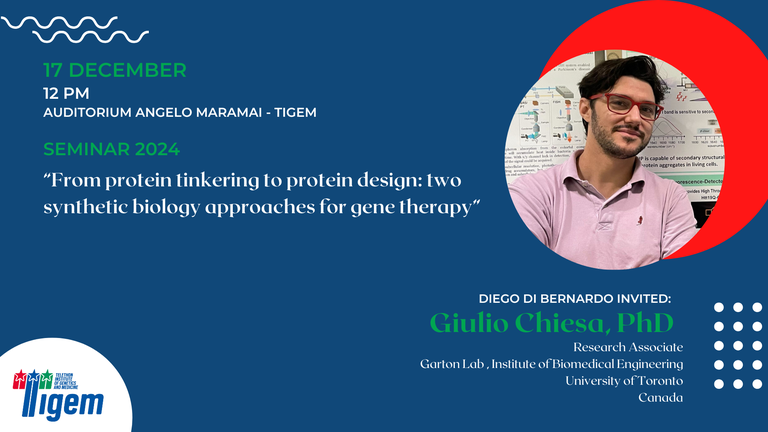Giulio Chiesa, PhD - "From protein tinkering to protein design: two synthetic biology approaches for gene therapy"
- When Dec 17, 2024 from 12:00 PM to 01:00 PM (Europe/Berlin / UTC100)
- Where Tigem Auditorium Angelo Maramai
- Contact Name Diego di Bernardo
- Contact Phone 08119230659
-
Add event to calendar
iCal

- https://www.tigem.it/newsroom/seminars/giulio-chiesa-phd-from-protein-tinkering-to-protein-design-two-synthetic-biology-approaches-for-gene-therapy
- Giulio Chiesa, PhD - "From protein tinkering to protein design: two synthetic biology approaches for gene therapy"
- 2024-12-17T12:00:00+01:00
- 2024-12-17T13:00:00+01:00
Giulio Chiesa, PhD
Research Associate
Garton Lab
Institute of Biomedical Engineering
University of Toronto
Canada
Short CV
Abstract
The synthetic biology manifesto declared that biology was “engineerable”. It’s been almost 25 years and only recently have we begun to engineer biological systems with a fair degree of success. Proteins are the perfect molecular system to engineer. They are composed of a finite species of parts (the amino acids), and they follow the rules of thermodynamics for folding.
There is now a multitude of engineered proteins, mostly obtained by tinkering with domains and functions. From this wealth of engineered proteins, it is now possible to assemble more complex multi-protein systems with emerging properties.
I will draw from my past and current projects to give two examples of synthetic macromolecular assemblies that perform a function. The first is produced by tinkering: we developed a biomolecular sensor for protein aggregation composed of three proteins interacting with a target aggregate. We used this sensor for studying tau and TDP-43 aggregation, two proteins involved in Alzheimer’s Disease. The second vignette involves machine learning applied to viral capsid design, as a new way to engineer proteins. We leveraged a generative model previously developed by our group to design novel Adeno-Associated Virus (AAV) serotypes with the goal of developing capsids not recognized by pre-existing neutralizing antibodies, thus democratizing the use of gene therapy.
Altogether, these vignettes are a sample of how protein design is evolving from tinkering to computer aided design.
